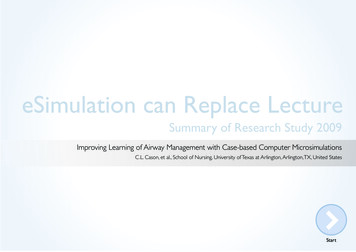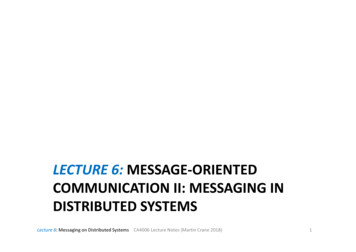
Transcription
eSimulation can Replace LectureSummary of Research Study 2009Improving Learning of Airway Management with Case-based Computer MicrosimulationsC.L. Cason, et al., School of Nursing, University of Texas at Arlington, Arlington, TX, United StatesStart
eSimulationIntroductionStudy Addressing Neomillenial Learning Stylesin Nursing EducationThe traditional classroom lecture is being challenged by larger class sizes and risingstudent/faculty ratios and by students looking for alternative learning modes. Fluentin multiple media, the neomillenial student seeks more personalized learning experiences, values direct participation and guidance, and prefers active learning based onreal situations with opportunities for reflection. As computer based self-directedlearning systems with patient scenarios designed to train medical knowledge, problem solving and decision-making skills fit right into the neomillenial mind set, therewas an interest in exploring whether this learning tool was at least as effective andefficient as traditional classroom lecture.PreviousNext
eSimulationPurpose of StudyThe purpose of this study was to evaluate the usefulness ofeSimulation in learning the principles and concepts of airwaymanagement by comparing learning outcomes achieved witheSimulation to those achieved with traditional lecture.2 primary questions were asked1Are there differerences in knowledge acquisition, knowledgetransfer, knowledge retention and timeliness/accuracy of caredecisions associated with instructional approach(Lecture vs eSimulation)?2Are there differences in learner receptivity associated withinstructional approach (Lecture vs eSimulation)?PreviousNext
eSimulationMethodInitial LearningFull-scaleSimulationLecture1 week(Bronchiolitis)KnowledgeAcquisition2 weeks8 weekseSimulation scenario(Acute asthma)Assessment Method:Written exam questionsKnowledgeRetentionKnowledgeTransfer3 weeksAssessment Method:eSimulation scenario(Severe asthma)*24 weeks(Accuracy/Timliness of Care)Assessment Method:OSCE following full-scalesimulation scenario(Acute respiratory distress)* Both groups had prior experience with eSimulation.PreviousNext
eSimulationSample Sizes1Lecture versus eSimulation2Receptivity to learning with eSimulationKnowledge AcquistionSurveyScores available from 76 students:38 students in Lecture Group38 in eSimulation GroupScores available from 49 students:26 students in Lecture Group23 in eSimulation GroupKnowledge TransferScores available from 76 students:38 students in Lecture Group38 in eSimulation GroupKnowledge RetentionScores available from 40 students:22 students in Lecture Group18 in eSimulation GroupPreviousNext
eSimulationResultsKnowledge AcquisitionLecture GroupeSimulation GroupWritten Exam Scores showing eSimulation was equally effective as was lecture. 190.8%73.0%78.9%74.3%correct score on unit examPrevious92.1%correct score on final exam80.3%correct score on all questionsNext
eSimulationResultsKnowledge TransferLecture GroupeSimulation GroupFirst attempt scores on the 2nd Computer Based Scenario showing the eSimulation group hadbetter scores on the eSimulation scenarios on Severe Asthma than did Lecture group. Lecturegroup achieved best scores equivalent to the eSimulation group on the same scenario but required longer engagement with the eSimulation scenario. 170.5%75.6%79.8%24.4 minutesAverage First ScorePrevious79.7%Average Best Score15.3 minutesTime spent completing senarioNext
eSimulationResultsKnowledge RetentionLecture GroupeSimulation GroupPerformance on the OSCE entailing assessment and care of an infant (SimBaby) in respiratorydistress showing the eSimulation group had significantly better retention on 3 key assessmentactions. 289%83%83%64%55%36%Assessed oxygen saturationPreviousAssessed respiratory rateNoted cyanosisNext
eSimulationResultsReceptivity to Learning All students were receptive to eSimulation. 1 Lecture group reported higher agreement that eSimulation strengthened understanding. 1 Both groups agreed eSimulation challenged their ability to think. 1PreviousNext
eSimulationConclusions Students learning concepts and principles of airway management via eSimulation outperformed those who learned via lecture. 3 The results suggest that systematic implementation of eSimulation for other care conceptsshould be evaluated as eSimulation may help graduates improve their readiness for practice. 3PreviousNext
eSimulationVocabulary Knowledge Acquisition: gaining knowledge Knowledge Transfer: applying gained knowledge to new situations Knowledge Retention: preservation of the after effects of experience and learning that makes recall or recognition possible. (www.merriam-webster.com) Decision Making Skills: accuracy and timeliness of care decisions (Cason, 2009) Learner Receptivity: Learner’s ability or inclination to receive Cyanosis: bluish or purplish discoloration of skin due to deficient oxygenation of blood. (www.merriam-webster.com) OSCE: Objective Structured Clinical Examination bster.com)Next
eSimulationReferences1. Improving learning of airway management with case-based computer microsimulations (Clinical Simulation in Nursing, 2010).Carolyn L. Cason, RN, PhD, Mary A. Cazzell, RN, BSN, Kristine A Nelson, RN, MN, Victoria Hartman, RN, NSN, CPNP, Jennifer Roye, RN, MSN, CPCP, MaryE. Mancini, RN, PhD, FAAN2. Learning the principles and concepts of airway management: The efficacy of replacing lecture with eSimulationTM (Final report, November 2008).Project Team: Carolyn L. Cason, RN, PhD, Professor and Associate Dean for Research, Principal Investigator; Kristine A. Nelson, RN, MN, Lead Teacher Undergraduate Pediatric Nursing Course, Project Coordinator; Victoria L. Hartman, RN, MSN, CPCP, Faculty, Undergraduate Pediatric Nursing Course, CoInvestigator; Jennifer Roye, RN, MSN, CPNP, Faculty, Undergraduate Pediatric Nursing Course, Co-Investigator; Mary E. Mancini, RN, PhD, FAAN, Professorand Associate Dean Undergraduate Program, Co-Investigator; and Mary Cazzell, RN, BSN, Graduate Research Assistant. University of Texas at Arlington,Arlington, TX, United States.3. Using eSimulation to enhance student nurses’ clinical skills [Abstract] (Society for Simulation in Healthcare, 2010).Carolyn L. Cason, RN, PhD, Mary A. Cazzell, RN, BSN, Kristine A Nelson, RN, MN, Victoria Hartman, RN, NSN, CPNP, Jennifer Roye, RN, MSN, CPCP, MaryE. Mancini, RN, PhD, FAAN4. Improving learning and performance with case-based computer simulations: eSimulationTM [Poster] (International Nursing Simulation/LearningResource Centers Conference, 2009).Carolyn L. Cason, RN, PhD, Kristine A Nelson, RN, MN, Victoria Hartman, RN, NSN, CPNP, Jennifer Roye, RN, MSN, CPCP, Mary E. Mancini, RN, PhD,FAANPreviousNext
eSimulationProfessor and Associate Dean for ResearchCarolyn L. Cason RN PhDProfessor and Associate Dean for ResearchDirector, Center for Nursing ResearchSchool of NursingUniversity of Texas at Arlington (Arlington, Texas)Carolyn Cason is Professor and Associate Dean for Research, School of Nursing, The University ofTexas at Arlington. She teaches in the PhD in Nursing program and serves as Administrator of theSmart HospitalTM, a Laerdal Center of Educational Excellence, a Hill-Rom, Inc National DemonstrationShowcase, and the CareFusion Nursing Discovery Center.Recommended links:The University of Texas at Arlington, School of NursingsSmart HospitalPreviousNext
eSimulationProduct InformationeSimulationSelf-directed learning systemFor this study the eSimulation application used was MicroSim InHospital by Laerdal Medical.eSimulation Inhospital is designed for use by all healthcare students and professionals, especiallyfor physicians, nurses, physician assistants, and medical residents.eSimulation Inhospital Modules: Airway & Breathing Chest Pain Cardiac Arrest 1 Cardiac Arrest 2 Cardiac Arrhythmia 1 (Tachydia) Cardiac Arrhythmia 2 (Bradycardia) Metabolic & Environmental Emergencies Poisoning & Overdose*Each module has 5 patient cases.PreviousEnd
Carolyn L. Cason RN PhD Professor and Associate Dean for Research Director, Center for Nursing Research School of Nursing University of Texas at Arlington (Arlington, Texas) Carolyn Cason is Professor and Associate Dean for Research, School of Nursing, The University of Texas at Arlington.










